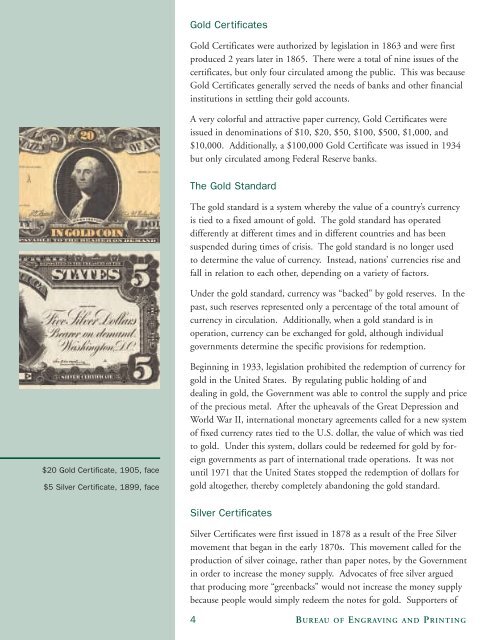Currency NOTES Currency NOTES - US Bureau of Engraving and ...
Currency NOTES Currency NOTES - US Bureau of Engraving and ...
Currency NOTES Currency NOTES - US Bureau of Engraving and ...
You also want an ePaper? Increase the reach of your titles
YUMPU automatically turns print PDFs into web optimized ePapers that Google loves.
$20 Gold Certificate, 905, face<br />
$5 Silver Certificate, 899, face<br />
Gold Certificates<br />
Gold Certificates were authorized by legislation in 1863 <strong>and</strong> were first<br />
produced 2 years later in 1865. There were a total <strong>of</strong> nine issues <strong>of</strong> the<br />
certificates, but only four circulated among the public. This was because<br />
Gold Certificates generally served the needs <strong>of</strong> banks <strong>and</strong> other financial<br />
institutions in settling their gold accounts.<br />
A very colorful <strong>and</strong> attractive paper currency, Gold Certificates were<br />
issued in denominations <strong>of</strong> $10, $20, $50, $100, $500, $1,000, <strong>and</strong><br />
$10,000. Additionally, a $100,000 Gold Certificate was issued in 1934<br />
but only circulated among Federal Reserve banks.<br />
The Gold St<strong>and</strong>ard<br />
The gold st<strong>and</strong>ard is a system whereby the value <strong>of</strong> a country’s currency<br />
is tied to a fixed amount <strong>of</strong> gold. The gold st<strong>and</strong>ard has operated<br />
differently at different times <strong>and</strong> in different countries <strong>and</strong> has been<br />
suspended during times <strong>of</strong> crisis. The gold st<strong>and</strong>ard is no longer used<br />
to determine the value <strong>of</strong> currency. Instead, nations’ currencies rise <strong>and</strong><br />
fall in relation to each other, depending on a variety <strong>of</strong> factors.<br />
Under the gold st<strong>and</strong>ard, currency was “backed” by gold reserves. In the<br />
past, such reserves represented only a percentage <strong>of</strong> the total amount <strong>of</strong><br />
currency in circulation. Additionally, when a gold st<strong>and</strong>ard is in<br />
operation, currency can be exchanged for gold, although individual<br />
governments determine the specific provisions for redemption.<br />
Beginning in 1933, legislation prohibited the redemption <strong>of</strong> currency for<br />
gold in the United States. By regulating public holding <strong>of</strong> <strong>and</strong><br />
dealing in gold, the Government was able to control the supply <strong>and</strong> price<br />
<strong>of</strong> the precious metal. After the upheavals <strong>of</strong> the Great Depression <strong>and</strong><br />
World War II, international monetary agreements called for a new system<br />
<strong>of</strong> fixed currency rates tied to the U.S. dollar, the value <strong>of</strong> which was tied<br />
to gold. Under this system, dollars could be redeemed for gold by foreign<br />
governments as part <strong>of</strong> international trade operations. It was not<br />
until 1971 that the United States stopped the redemption <strong>of</strong> dollars for<br />
gold altogether, thereby completely ab<strong>and</strong>oning the gold st<strong>and</strong>ard.<br />
Silver Certificates<br />
Silver Certificates were first issued in 1878 as a result <strong>of</strong> the Free Silver<br />
movement that began in the early 1870s. This movement called for the<br />
production <strong>of</strong> silver coinage, rather than paper notes, by the Government<br />
in order to increase the money supply. Advocates <strong>of</strong> free silver argued<br />
that producing more “greenbacks” would not increase the money supply<br />
because people would simply redeem the notes for gold. Supporters <strong>of</strong><br />
4 <strong>Bureau</strong> <strong>of</strong> engraving <strong>and</strong> Printing


